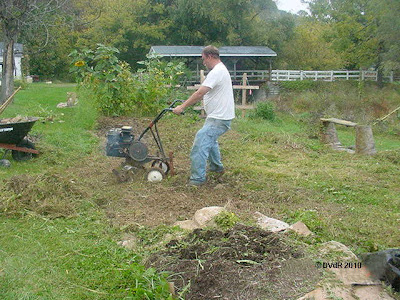For sure, my garden needs a transformation from all the neglect! I need to make beds to plant with garlic and shallots, and by the looks of the mess, it will be a sore chore.
First, till and remove all the grass, weeds and their roots... Luckily I was able to hire a helper.
I ran string lines for rows 36" wide with 12" pathways between them, and then piled all the dirt from the paths onto the rows.
First bed, ready to plant. The rest soon followed and I have 3 lovely rows of fluffy soil which I hope will drain well even if the creek floods (which it does, but usually not up that far).
Next, lay out the garlic clove rows, 6" apart. They will get buried about 4" deep, with the tip planted UP.
After planting, the garlic rows get a covering of around 3 inches of straw. If our Fall is mild, the garlic will put up green shoots in several weeks. That growth spurt helps put down roots, and the green tops will die down for winter. In spring the tops will begin to grow again and the roots will make a new garlic bulb.
On to shallot layout. Planting shallots is a little different than planting garlic. When shallots grow, they form a cluster or clump around the shallot planted, rather than forming cloves the way garlic does. I plant shallots at least 8" apart in rows that are about a foot apart.
The shallots must be planted with the top of the neck just peeking above the soil. This keeps rain (even in the form of snow) from seeping into the shallot and rotting it. In some colder areas, shallots not hardy enough to plant in the fall. It's always "try it and see" for me in my zone; if the winter is exceedingly cold, these may not survive, especially being planted so close to the surface. Shallots generally do not get a mulch cover either, as this can encourage bulb rot. I do mulch if a cold winter has set in, but not until around Christmas. I also remove the mulch at the first signs of warming in the new year.
The garlic and shallots should be watered well after planting, and not watered again until quite dry. Usually I water 2-3 times before Thanksgiving, depending on the weather. Right now it has been very dry so it may take more watering. They need about an inch of water a week.
In the spring before bulb formation begins, I will side-dress the garlic and shallots again with trace minerals and well-composted manure. Voila! Garlic and shallots coming to my table soon!!









I love growing garlic. It's so easy once you get the beds right. How wonderful that you have a helper.
ReplyDeleteThanks. Despite the lousy economic conditions, getting a helper isn't easy around here. No one wants to work!
ReplyDeleteWhat a transformation!
ReplyDeleteLOL... amazing what a (hired) strong back and some determination (my part) can do!
ReplyDeleteTimely suggestion! Thanks, Darius. Once you grow your own garlic, you'll feel the same way about that as your own tomatoes--just no comparison. For an easier, lazy way: I quit tilling a couple of years ago, so straw or rotted hay (Ruth Stout) are my 'tiller'. I planted potatoes on top of brome grass in March by just tossing the potato parts on top and burying under 8" of straw, adding more as necessary. Harvested taters, then in early Nov. used the same patch by digging the earthworm-tilled soil with my gloved hands planting the garlic 3" apart. The soil was so yummy smelling and loose that I spent virtually no time with any of it (esp. weeding-it killed nearly all the perennial grass) and I got good results even though I watered only 2x during long droughts. I am a total Stoutite now! You introduced me to Brix, so I'm trying to incorporate that, too. Boy, do I have a lot to learn!
ReplyDeleteThanks! I love Ruth Stout, have had her book for years, and follow it as I can. That bed just didn't get enough mulch. (I think the creek flooding must have washed it away.) The other beds higher up stayed more like your description with the additions of straw and hay to decompose, but they still need more humus.
ReplyDeleteLast year was the first year in more than a decade that I didn't grow garlic, shallots and leeks. I sorely missed having my own!
hi, Darius,
ReplyDeleteyou sound like me - only busier! i also live in the Appalachians - NC, am looking for ways to garden with a disability, and found your article on straw bales on Dave's Garden. well written article and one that should become useful next year when we start up again. currently the bales are used for the dog yard especially when the weather goes from very dry to very wet (serious mud). so thanks for your insights. gail caduff-nash
Gail, glad to 'meet' you! I moved here from Asheville, and before that, Boone. I miss NC fiercely! Good luck on bale gardening, it's fun!
ReplyDelete